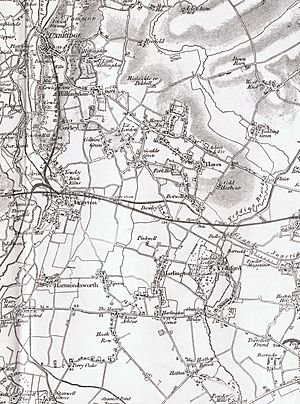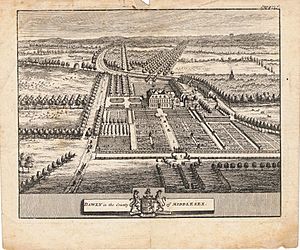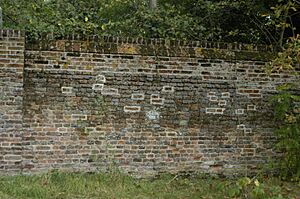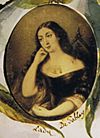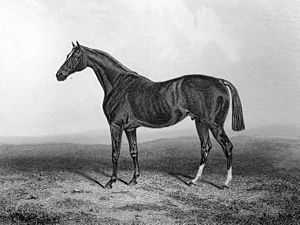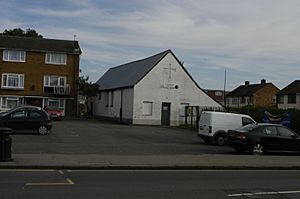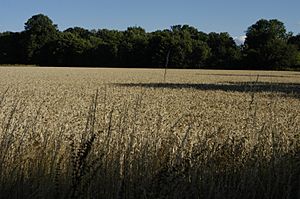Harlington, London facts for kids
Quick facts for kids Harlington |
|
|---|---|
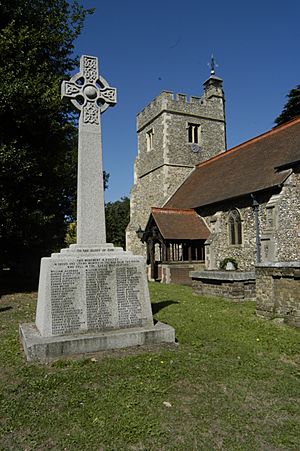 The Grade I Listed parish church is the oldest of the listed buildings in Harlington. The War Memorial was designed by C. O. Scott. |
|
| OS grid reference | TQ085775 |
| • Charing Cross | 13.5 mi (21.7 km) E |
| London borough | |
| Ceremonial county | Greater London |
| Region | |
| Country | England |
| Sovereign state | United Kingdom |
| Post town | HAYES |
| Postcode district | UB3 |
| Dialling code | 020 |
| Police | Metropolitan |
| Fire | London |
| Ambulance | London |
| EU Parliament | London |
| UK Parliament |
|
| London Assembly |
|
Harlington is a district in Hayes, located in the London Borough of Hillingdon. It's one of the historic areas that helped form parts of London Heathrow Airport and its surrounding businesses. Harlington is about 13.6 miles (21.9 km) west of Charing Cross in central London. It is next to Hayes and shares a train station, Hayes & Harlington railway station, which is on the Great Western Main Line. Harlington is in the west of Greater London and was part of Middlesex county until 1965.
Contents
What's in a Name? (Etymology)
The name Harlington comes from an old Anglo-Saxon phrase, Hygereding tun. This means "Hygered's people's farmstead."
Harlington's Past (History)
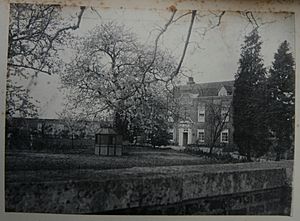
The first time Harlington is mentioned in writing is in a document from the 9th century. This document describes land in nearby Hayes and says its western edge was near "Hygeredington," which is Harlington. The border between Hayes and Harlington was later marked by roads like North Hyde Road and Dawley Road.
How Harlington Was Governed (Administrative History)
In the 1800s, local people worked together to improve Harlington. For example, in 1824, they hired a doctor for the poor in Harlington and Cranford. They also worked together to open Harlington's National School in 1848 and a small hospital in 1884.
Here's how Harlington's local government changed over time:
| Dates | Entities | ||
|---|---|---|---|
| c. 1840 | Harlington Parish (a local area) | ||
| 1872 | Staines Rural Sanitary District (focused on health) | ||
| 1889 | Middlesex County Council (county government) | ||
| 1894 | Staines Rural District (a larger local area) | ||
| 1930 | Hayes and Harlington Urban District (joined with Hayes) | ||
| 1965 | London Borough of Hillingdon (part of London today) | ||
In 1924, the local council asked for street lights, which were installed a year later. A cemetery was opened in 1936. The council also started community gardens (allotments) in 1895.
Keeping Harlington Clean (Sanitation)
A big job for local government in the late 1800s and early 1900s was building sewers. As more people moved to Harlington and flush toilets became common, proper waste disposal was very important. For example, there were cases of typhoid (a serious illness) in 1912 and diphtheria in 1916.
In the 1920s, plans were made to build sewers. Harlington's local council decided to join with Hayes in 1930 because it seemed like the best and cheapest way to get sewers built quickly. A full sewer system for Harlington was finished in 1934.
Harlington Today (Present Day)
Harlington Library is located in the northern part of the village.
The area has six public houses (pubs): Captain Morgans', The Great Western, The Pheasant, The Red Lion, The Wheatsheaf, and The White Hart. There are two churches: a Baptist church and the Church of England church, St Peter & St Paul's. Harlington School is one of the local schools.
Hellenic Imperial Airways has its UK offices in Harlington. The Harlington Locomotive Society operates a miniature railway on the High Street, on the site of an old orchard. Harlington also has its own community radio station, 91.8 Hayes FM.
Churches
- S.S. Peter and Paul's Church has sculptures by famous artists like Edgar Boehm and William Theed. It also features beautiful stained glass by Charles Eamer Kempe.
Gallery
-
Bridge 196 over the Grand Union Canal at Dawley, Harlington.
-
Part of a Thomas Kitchin map showing Dawley and Harlington, around 1770.
Getting Around Harlington (Transport)
Harlington is served by Hayes & Harlington railway station. You can catch Elizabeth Line trains from here to places like London Paddington, Shenfield, Abbey Wood, Heathrow Airport, and Reading.
Several bus routes also serve Harlington:
- 81 Hounslow Bus Station - Slough
- 90 Feltham - Northolt
- 111 Kingston - Heathrow Central
- 140 Heathrow Central - Harrow Weald
- 222 Hounslow Bus Station - Uxbridge
- 285 Kingston - Heathrow Central
- H98 Hounslow Bus Station - Hayes End
Old Ways to Travel (Historic Transport)
The Grand Junction Canal (now part of the Grand Union Canal) runs through the Dawley area of Harlington. It was built between 1794 and 1800.
In the late 1830s, the main line of the Great Western Railway was also built across what was once Dawley Park. However, the Hayes & Harlington railway station didn't open until 1864. Before that, people had to use stations in West Drayton or Southall, or take an omnibus (a type of bus) or carrier service to London.
A road that went south-east towards Hatton was removed when Heathrow Airport was built.
Former Cottage Hospital
The Harlington, Harmondsworth and Cranford Cottage Hospital was located on Sipson Lane. It opened in 1884 but was taken down in 1977. Today, a branch of the Sant Nirankari Satsang Bhawan is on its site.
Special Old Buildings (Listed Buildings)
"Listed buildings" are important buildings that are protected because of their history or special design.
| name | type | built | use and main features |
|---|---|---|---|
| Church of St. Peter & St. Paul (Grade One Listed) | Religious | 12th century | A Christian church. It has a very old yew tree in its churchyard, which was once a famous example of topiary (shaped plants). |
| Veysey's Farm | Farm | late 18th century | Used for farming and nature. |
| Shackle's Barn | Agricultural | early 1800s | Now used as a Scouts headquarters. |
| Barn at Manor Farm | Agricultural | Restored in the 1970s and now used as offices. It has a timber frame. | |
| Small hospital (Sipson Lane) | Social | 1884 | Now a Hindu faith centre. |
| Dower House (High Street) | House | 16th century | An old house with a Timber framed structure. |
| Harlington Baptist Church | Religious | 1879 | A Christian church. |
Old Buildings That Are No Longer Here (Former Listed Buildings)
Some historic buildings in Harlington have been taken down over time:
| name!!type!!built!!demolished (exact or between dates) | use | |||
| Dawley Manor Farm | House | 17th century | 1962 | Its site is now part of the M4 motorway and St Peter's Way. |
| Shackle's House | House | early 1800s | 1960–70 | Its site is now Pembury Court (a street). |
| Harlington rectory | House | Victorian | 1970 | Its site is now homes and the new church hall. |
| Old Church Hall | Church hall | early 1900s | 1970 | Was in the rectory grounds. Now homes. |
| Bletchmore House | House | 1970–80 | Its site is now Bletchmore Close. | |
| Woodlands Farmhouse | House | 1960–65 | Its site is now 178-182 High Street. | |
| Poplar House | House | 18th century | 1970–75 | Its site is now Felbridge Court (apartments). |
Manor Farm was taken down between 1930 and 1940. It was too old to be officially listed as a protected building. Shops in Manor Parade and nearby roads are now on its site.
Famous People from Harlington (Notable People)
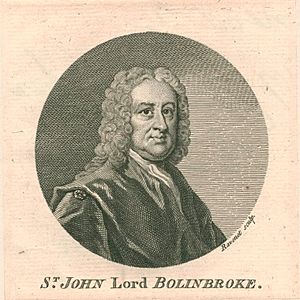
Many interesting people have lived in or been connected to Harlington:
- John Derby Allcroft (glove maker and helper of others) lived at Harlington Lodge.
- Henry Bennet, 1st Earl of Arlington (1618–1685), a statesman who worked for King Charles II, was born in Harlington and took his title from the area. His family owned a large estate in Harlington, including Dawley House.
- Henry St John, 1st Viscount Bolingbroke (1678–1751) was a politician and philosopher who lived at Dawley House. He bought the house in 1724 and worked on its large park and gardens.
- Dame Lettice Poyntz (died around 1610) left £100 to the village, which was used to buy land to support good causes.
- Richard Tattersall (1724–1795), who founded the famous horse auction company Tattersalls, started a horse breeding farm at Dawley (also called Dawley Wall Farm) around 1779. Famous racehorses like Glencoe and Middleton were kept there.
- Composer William Byrd (1539/40-1623) lived in Harlington as a Catholic from 1578 to 1588.
- Sports organizer Simon Clegg was born in Harlington.
- Former professional footballer and manager Paul Goddard was born in Harlington.
- The de Salis family owned a lot of land in Harlington, especially in the north, including Dawley House. Several family members are buried in Harlington's churchyard.
- John Kite (died 1537) was the Rector of Harlington until 1510 before becoming a Bishop.
- William Roper (around 1496 – 1578), who was the son-in-law of Thomas More, owned the manor of Harlington with his son from 1551 to 1583.
- Roger, Earl of Shrewsbury was the Lord of the Manor in 1086.
- Joseph Trapp (1679–1747) was the rector of Harlington from 1733 to 1748. He was also a scholar, poet, and writer.
- Animal scientist Eric Underwood (1905–1980) was born in Harlington.
- Wigot of Wallingford was the Lord of the Manor during the time of Edward the Confessor.
- Football clubs like Chelsea (until 2005), Queens Park Rangers (2005-2023), and Wycombe Wanderers (from 2024) have used the Imperial College Sports Ground, also known as Harlington Sports Ground.
Sports in Harlington (Sport)
A greyhound racing track opened in Harlington in the 1930s, near the Bath Road. This was an "independent" track, meaning it wasn't part of the main racing organization. In 1959, plans were made to build two large hotels (The Skyways and Ariel, now Sheraton and Holiday Inn) to serve Heathrow Airport. This meant the track had to be taken down, and the last race was on January 22, 1962. The Holiday Inn today is very close to where the track used to be.



